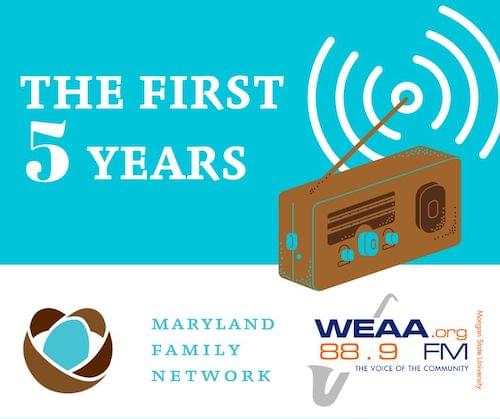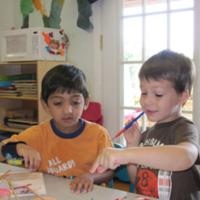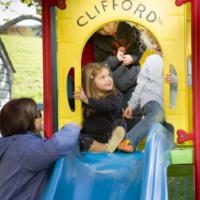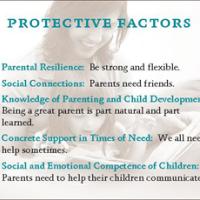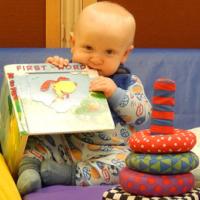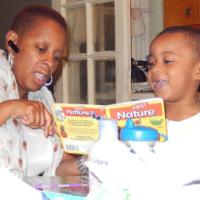Research has determined that the foundation for educational achievement is well-established before children enter school. Educators have identified a wide range of skills and competencies that help children succeed in school by allowing them to express themselves verbally, manage their emotions, use small and large motor skills, explore and solve problems.
Resources
Maryland Model for School Readiness: The Division of Early Childhood Development in the Maryland State Department of Education (MSDE) provides information on school readiness. Parents may want to scroll down to "What is MMSR" for an overview. (MSDE)
School Readiness Assessment is conducted by kindergarten teachers for every child. Aggregated assessment data is available for Maryland and for each jurisdiction. (MSDE)
The School Ready Infographic provides a visual overview of development from infancy to age 5. (ZERO TO THREE: National Center for Infants, Toddlers, and Families)
Quality child care can be found in many settings - family child care, center-based care, Head Start or preschool. Indicators of quality include warm relationships, safe and stimulating environment, and developmentally appropriate planned activities for play-based learning.
Resources
Is This the Right Place for My Child? 38 Research-based Indicators of Quality Child Care (Child Care Aware)
Essentials for Your Child Care Visit (Child Care Aware)
Family Support helps families identify strengths, set goals, and work toward them. Family Support Centers work with disadvantaged parents and young children, providing children with stimulating, nurturing child care while their parents take classes ranging from GED preparation to parenting techniques to life and job skills.
Resources
A Win-Win for Struggling Parents about adult education and GED preparation at a Family Support Center;
What Adults Learn from Play about coaching parents as they engage in child-directed play;
A New Delivery Model for Family Support about a Community Hub; and
In the Door and On the Floor where you can watch a home visit in action.
Strengthening Families is an approach to promoting healthy family functioning. Taken together, protective and promotive factors increase the probability of positive, adaptive and healthy outcomes, even in the face of risk and adversity.
Resources
Protective and Promotive Factors provides an explanation of the factors that mitigate or eliminate the risk of negative outcomes, as well as factors that actively enhance well-being. (Center for the Study of Social Policy)
Core Meanings of the Protective Factors provides examples that explain the Protective Factors. (Center for the Study of Social Policy)
The Five Things All Families Need (4 minute video) describes the five Protective Factors that are the core of the Strengthening Families approach. It includes video of participants in a Parent Café, the primary method of spreading information about the Protective Factors. (Maryland Family Network)
For more information, visit the Center for the Study of Social Policy.
Every child needs one person who is crazy about him, said renowned psychologist Uri Bronfenbrenner. This affirming human connection is the prerequisite for healthy social and emotional development, which is a necessary foundation for all learning.
Resources
Backpack Connection A series of one-page guides on topics such as teaching children new skills and expectations; stopping whining; using positive language to improve behavior; helping your child understand sadness, anger, frustration, jealousy, or disappointment.
The primary online source for early childhood professionals concerned with the Social and Emotional Foundations of Early Learning (SEFEL) is maintained by Vanderbilt University.
The online SEFEL source for early childhood professionals in Maryland is maintained by the University of Maryland School of Social Work.
"Tucker the Turtle" video (2 minutes) shows an anger management technique in practice at a child care center.
When it comes to the economics of child care, both sides are hurting. For parents, the cost of child care is a huge financial burden. For child care providers, the financial compensation is grossly inadequate. Maryland Family Network collects and analyses extensive data about the demand, supply, and cost of child care in Maryland. Child Care Demographics 2013 includes data on population, income, workforce participation, and child care in Maryland.
Resources
Child Care Demographics 2015: Jurisdictional Reports provide county-level data for Baltimore City and the 23 counties in Maryland.
Trends in Child Care 2015 provides a state-level summary of demand, supply, and cost of child care in Maryland from 2008 and projecting to 2017.
For international comparisons of government subsidy for early care and education, see The United States is Trailing Other Countries on Early Education Investment and Enrollment (including colorful infographic) from Center for American Progress.
Education at a Glance 2012 provides international comparisons on access to preschool on page 74 - 75.
Innocenti Report Care 11 from UNICEF’s Office of Research ranks the U.S. as 26th out of 28 developed nations in the provision of preschool to 4-year olds. In addition, the Report Card offers many other indicators of child well-being.
You often hear it said that "Children are resilient" - but perhaps not as resilient as we’d like to believe. There is staggering evidence that trauma in childhood has lasting effects and directly contributes to health, social, and economic outcomes in adulthood. The most prominent research related to the lasting effects of childhood trauma is called the Adverse Childhood Experiences (ACE) study.
Resources
The Centers for Disease Control and Prevention provides an overview of the ACE study and information about public health leadership to prevent child maltreatment.
The ACE Score Calculator lets individuals determine their exposure to adverse childhood experiences.
From birth, children are intensely engaged in learning how to learn. They are propelled by motivation, attitudes, and habits that experts call "approaches to learning."
Resources
Although intended for its teachers, Head Start’s "Approaches to Learning" offers clear explanation about why each approach to learning is important and suggests ways to nurture their development. It’s interesting to note that "approaches to learning" captures the essence of the "plan, do, review" process that is the core of the teaching method developed by High Scope at the reknown Perry Preschool Project.
Watch MFN’s video on persistence and problem solving, two traits that support early learning.
Home visiting, which reaches families with young children in extreme need, has been linked to positive outcomes, including reductions in infant deaths and childhood injuries; as well as increases in school readiness.
Resources
In the Door and On the Floor: Watch a Home Visit in Action (video from Maryland Family Network)
Playing in and with boxes is great fun for kids, and it's also a learning opportunity. It's empowering because the child gets to decide what the box is going to be, exercising her ingenuity, problem-solving skills, and spatial ability.


